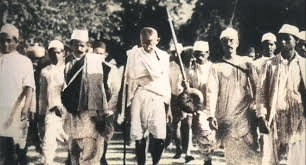On October 13, 1940 Gandhi declared his line of action in the Working Committee of Congress. The plan was to start ‘individual satyagrah’ according to it few people chosen by Gandhi would offer civil disobedience and court arrest. The second stage of the campaign began on the November 17 and it was termed as the ‘representative satyagrah’. Individuals were selected from groups and they were assigned to raise anti war slogans in the streets and got themselves arrested. By the end of the year, five to six hundred persons were imprisoned. Although some top most Congress leaders were arrested during the campaign but it was not turned into a national revolt. There was no disorganization, no mass protests and the average Congressman felt that the political thinking and action could be left to Gandhi and his elite advisors.
The campaign failed in the Muslim provinces. North West Frontier Province was the least affected in the whole of India. At first Khan Sahib was reluctant to participate in it but when finally he did and got arrested on the December 14, people remained calm and there was no general discontent among the populace. In Bengal the people were not at all attracted to the idea of Gandhi.
In April 1941 Gandhi opened the satyagrah campaign to all Congressmen. At one time 14000 Congress members were in jail. But it wasn’t a significant figure in proportion to the total Congress membership. By October only 5600 persons remained in jail. With the passage of time the number of satyagrahies kept on decreasing. Though the movement continued for few more months but it was nothing more than a token gesture of defiance.
The Muslims of South Asia were not in favour of the Congress policies. Firstly they were not willing to change one
master for another. Secondly Muslim League wanted to consolidate and popularize the idea of Pakistan and for that they didn’t want to have a complete break with the British Government. Thirdly the Congress campaign of civil disobedience was untimely. It was clear to all that any movement violent or non-violent was not going to persuade the British to grant Indian independence in the middle of the Second World War. In November 1940 Quaid-i-Azam in his speech at Delhi clearly said that Congress had wrongly claimed that its campaign had been launched for the freedom of India, it was clear to all that it was intended to pressurize the British Government to recognize Congress as the only authoritative and representative organization of the Indian people. The Muslim League in its Madras annual session of April 1941 reiterated that the Congress civil resistance was aimed at relegating the Muslim nation of one hundred million and the Indian minorities to the status of mere subjects of Hindu raj through out the country. They warned the Government that any constitutional change enacted under Congress threat would be unacceptable to the Muslim League and they would resist it with all the power they could command.
This article was last updated on Monday, Jan 01, 2007






